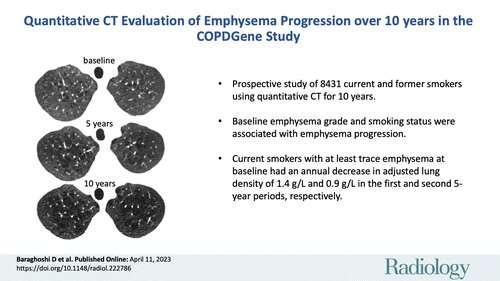This article has been reviewed according to Science X's editorial process and policies. Editors have highlighted the following attributes while ensuring the content's credibility:
fact-checked
peer-reviewed publication
trusted source
proofread
COPDGene study follows emphysema patients over 10 years

Researchers at National Jewish Health evaluating computerized tomography (CT) scans of emphysema progression in the COPDGene study showed that, during a span of 10 years, participants with pre-existing emphysema who continued smoking had the largest decline in adjusted lung density (ALD). The lung density decline was notably worse in current smokers compared with former smokers.
The study is significant because reliably measuring changes in emphysema over time has always been challenging, due in part to differences in CT equipment technology and imaging parameters across institutions. The study, which was published in April in the journal Radiology, accounts for many of the sources of variability.
Chronic obstructive pulmonary disease (COPD) affects an estimated 5% of the population and is the fourth most common cause of death in the United States. COPDGene is one of the largest studies ever to investigate the underlying genetic factors of COPD. With the use of CT scans, COPDGene has been seeking to better classify COPD and increase understanding of how the disease may differ from person to person. Emphysema is one of the diseases that comprises COPD.
"Using CT, we were able to show that emphysema progresses significantly faster in patients with existing emphysema and who continue to smoke," said David Lynch, MB, radiologist and senior author on the research. "This is also impactful in that we were able to use CT scans to identify the progression of emphysema over time, while adjusting for multiple sources of variation."
Between 2008 and 2011, over 10,000 cigarette smokers with and without COPD were enrolled in the study at 21 centers across the U.S. Participants underwent baseline evaluation and returned for a 5-year and 10-year follow-up. Emphysema progression was modeled using ALD based on quantitative CT. Emphysema progression was greatest in current smokers who had more than trace emphysema at the beginning baseline.
"Among patients with pre-existing emphysema, the difference in the rate of emphysema progression between current and former smokers shows the need for smoking cessation," said David Baraghoshi, MSTAT, research assistant in the Division of Biostatistics and Bioinformatics at National Jewish Health, and first author on the research.
More information: David Baraghoshi et al, Quantitative CT Evaluation of Emphysema Progression over 10 Years in the COPDGene Study, Radiology (2023). DOI: 10.1148/radiol.222786





















